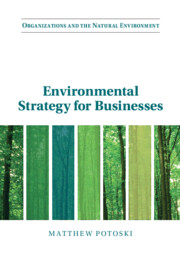Book contents
- Environmental Strategy for Businesses
- Organizations and the Natural Environment
- Environmental Strategy for Businesses
- Copyright page
- Contents
- Tables
- Preface
- 1 Introduction
- 2 Foundations and Background
- 3 Environmental Strategy Choices and Challenges
- 4 Nonmarket Strategy
- 5 Environmental Strategy and Strategic Resources
- 6 Green Products and Services
- 7 Employee Engagement
- 8 Environmental Groups
- 9 Conclusion
- References
- Index
9 - Conclusion
Published online by Cambridge University Press: 23 February 2023
- Environmental Strategy for Businesses
- Organizations and the Natural Environment
- Environmental Strategy for Businesses
- Copyright page
- Contents
- Tables
- Preface
- 1 Introduction
- 2 Foundations and Background
- 3 Environmental Strategy Choices and Challenges
- 4 Nonmarket Strategy
- 5 Environmental Strategy and Strategic Resources
- 6 Green Products and Services
- 7 Employee Engagement
- 8 Environmental Groups
- 9 Conclusion
- References
- Index
Summary
Not every potential environmental improvement is an opportunity for a successful environmental strategy. Success depends on the strategy’s fit with stakeholder demand, channels to capture value from stakeholders, and credibility assurances that the company’s environmental achievements are genuine, as well as its alignment with the company’s overall strategy and strategic resources. The case of Nike’s Considered sustainability initiatives illustrates environmental strategy’s promise and pitfalls. Nike’s Considered Boot was launched to considerable acclaim and received international awards for its advanced sustainability design. The Considered Boot’s rugged look clashed with the sleek styling and performance features that typified the Nike brand and offered few other benefits that enticed consumers. As Nike withdrew the Considered Boot from consumer markets, it leveraged its advanced apparel design expertise to develop more sustainable features for products and to produce tools for measuring products’ sustainability. By making these features and tools public, Nike helped its environmental group stakeholders assess environmental performance throughout the apparel industry. Nike thus aligned its environmental strategy with its nonmarket strategy by allowing environmental groups to pressure competitors to improve their performance to standards Nike had already achieved, thereby raising competitors’ costs.
Keywords
- Type
- Chapter
- Information
- Environmental Strategy for Businesses , pp. 175 - 190Publisher: Cambridge University PressPrint publication year: 2023



